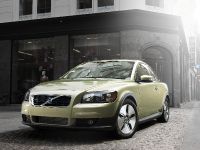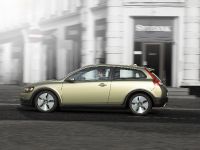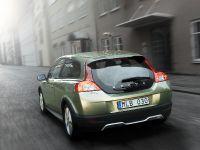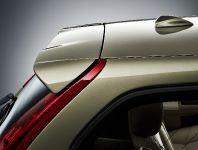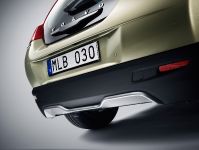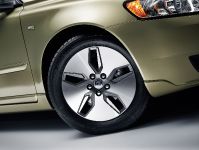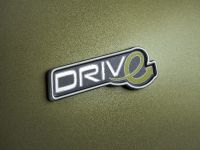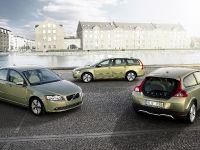Volvo presents seven new cars with the green DRIVe badge
At the Geneva motor show, Volvo Cars is presenting no less than seven fuel-efficient DRIVe models. All with best-in-class CO2 emission levels. The extremely low figures for the C30, S40 and V50 have been achieved thanks to an advanced Start/Stop system.
* Volvo C30, 3.9 l/100km, 104g CO2/km * Volvo S40, 4.0 l/100km, 107g, CO2/km * Volvo V50, 4.0 l/100km, 107g, CO2/km * Volvo V70, 4.9 l/100km, 129g, CO2/km * Volvo S80, 4.9 l/100km, 129g CO2/km * Volvo XC60, 6.0 l/100km, 159g CO2/km * Volvo XC70, 6.0 l/100km, 159g CO2/km
The DRIVe badge is attached to cars in the Volvo range that have the best environmental performance in their class. All today's DRIVe models are equipped with a conventional diesel engine and manual gearbox optimised for extra-low fuel consumption. These cars are also tailored specifically for low rolling resistance and reduced air drag.
"Our dedicated focus on the DRIVe models in 2009 demonstrates Volvo Cars' ability to quickly respond to customers' increasing demands for products with low fuel consumption and low environmental impact. At the Paris motor show in 2008, we began our broad-based launch of the DRIVe models via the C30, S40 and V50. Now both the market and we are ready to step up to the next stage," says Stephen Odell, President and CEO of Volvo Cars.
"By supplementing the DRIVe range with the larger V70, S80, XC60 and XC70, Volvo also has one of the premium segment's strongest ranges of attractive, fuel-efficient cars offering excellent environmental properties," continues Stephen Odell.
DRIVe at three levels: 120g, 140g, 160g The Volvo Cars DRIVe range is divided into three categories linked to three emission levels: 120, 140, and 160g CO2/km.
"The categories signal Volvo's highly ambitious CO2 targets in each respective segment. They also match the special CO2 tax brackets and other governmental green-car incentives found in many European countries. Our aim is to continue to further reduce these levels as we develop new, even more environmentally optimised products," explains Stephen Odell.
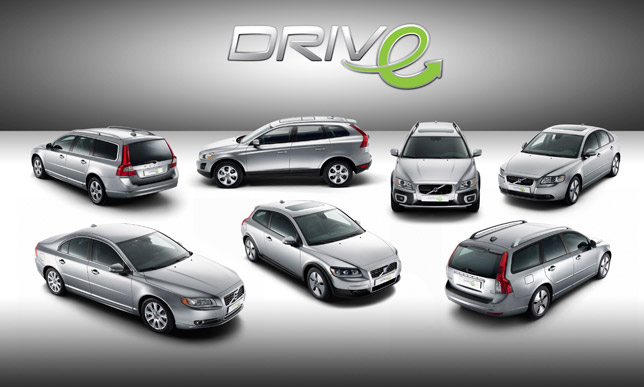
C30, S40, V50 way below 120g As of spring 2009, the Volvo C30, S40 and V50 1.6D DRIVe will be offered with an advanced Start/Stop function. This helps lower emissions to just 104g CO2/km for the Volvo C30 and 107g CO2/km for the S40 and the V50 family estate model. The C30 thus also meets the lowest eco-tax levels (105g) in Europe.
The first Volvo models with Start/Stop function In order to reduce carbon dioxide emissions to such an extent, the new DRIVe versions of the C30, S40 and V50 have been equipped with two intelligent new features. One is a Start/Stop function that allows the engine to switch off when the car is at a standstill, for instance while waiting at traffic lights or when stuck in traffic queues.
If the driver puts the gear lever into neutral and releases the clutch while at a standstill, the engine switches off. The next time the driver presses the clutch, the engine starts up again. This technology can reduce fuel consumption and thus carbon dioxide emissions by 4-5% in mixed driving conditions. Start/Stop technology is particularly effective in urban traffic, when the saving may be as much as 8%.
Volvo-unique levels of comfort and quick start-up time While the car is at a standstill and the engine is switched off, some electronic systems such as the air conditioning step down to standby level in order to save fuel. However, the Start/Stop system continuously monitors the comfort level and automatically reactivates the relevant systems if for instance the temperature increases in the passenger compartment. The system does not set any limits for comfort-enhancing features such as the sound system or other facilities that the customer wants to maintain.
This monitoring system, which is specific to Volvo Cars, and the resultant high comfort level have been made possible owing to an additional small battery that supports the larger battery by providing extra power. Thanks to this extra battery, Volvo's DRIVe models also feature particularly quick and smooth start-up and the audio system, for instance, remains totally unaffected when the starter motor is activated. This distinguishes Volvo Car's solution from that offered by the competition. What is more, the standard larger battery has been upgraded to handle up to 175,000 Start/Stop cycles.
The driver continuously receives feedback about system status via the in-car information display. The Start/Stop function can be engaged and disengaged via a special DRIVe button in the centre console. In the default setting, the function is activated. In the future, this special DRIVe button will also regulate additional systems such as the DRIVe "economy settings" for particularly fuel-efficient performance that are on the way in forthcoming models.
Charges the batteries via kinetic energy The other new feature in the C30, S40 and V50 DRIVe 1.6D with Start/Stop is what is known as a regenerative charge facility. This is a function that charges the battery as soon as the driver releases the accelerator or brakes while a gear is engaged. By harnessing the car's kinetic energy, the alternator does not have to use diesel fuel as a power source when the battery's charge level dips. Fuel savings of between 2 and 3% can be achieved with this function.

V70 and S80 slip below 140g For the first time ever, the Volvo V70 and S80 are now also being offered in DRIVe versions. The cars are equipped with the same powertrain - 1.6-litre diesel engine and manual gearbox - as the smaller models but with specially tailored engine software and different ratios in third, fourth and fifth gears.
The optimised powertrain is a major aid in helping Volvo's larger sedans and family cars significantly cut their fuel consumption and CO2 emissions:
* V70 down to 4.9 l/100 km and 129g, an improvement of 18% compared with today's two-litre diesel. * S80 down to 4.9 l/100 km and 129g, an improvement of 15% compared with the two-litre diesel.
"We feel that the customer should not have to compromise on either driving properties or comfort despite the smaller engine size. These cars have perfectly adequate performance and in addition a very low environmental impact, actually at a level that none of the competitors in this size class even begin to approach," says Magnus Jonsson, Senior Vice President, Product Development at Volvo Cars.
Several other factors also contribute to the reduction in fuel consumption, for example the tyres that have been specially designed for low rolling resistance. For the first time the V70 and S80 DRIVe versions are also equipped with an electric power steering pump that delivers exactly the servo assistance the driver requires, in a precise and energy-efficient way. All DRIVe models feature this power steering system.
The V70 has the following special features to reduce air drag:
* Covered grille * Lowered chassis (20 mm front, 15 mm rear)
XC60 and XC70 now below 160g For model year 2010, the powertrain range for the new Volvo XC60 crossover and the XC70 adventure estate will expand with a front-wheel drive DRIVe version powered by the 2.4D engine. CO2 emissions will be 159 g/km and fuel consumption a best-in-class 6.0 l/100 km for both cars.
In addition to front-wheel drive, a number of minor improvements all help deliver the new model's competitive fuel consumption and CO2 figures. Volvo Cars' engine experts have also succeeded in reducing friction and pump losses in the diesel engine and in cutting the pressure drop in the intake and exhaust systems.
Injection pressure has increased with the latest generation of high-pressure pumps and the injection architecture has been refined with the help of a piezo-electric system. The engine now has lower compression, more efficient combustion and the latest generation of engine management software. What is more, the turbocharger has been optimised to deliver high torque from low revs.
The gear ratios have been optimised so the car can be driven economically. For instance, when driving at 100 km/h in top gear, engine revs and thus also fuel consumption are lower with the new powertrain.
One important part of the development brief was to retain the sporty driving properties that are a central part of these cars' attraction.
"More horsepower, higher torque and a sporty chassis setting all help give the front-wheel drive version the right XC60 dynamics. It is the perfect choice for the customer who wants to focus on CO2 emissions without compromising on driving pleasure," says Magnus Jonsson.
"The XC70 DRIVe succeeds in combining high comfort and get-you-there ability with low fuel consumption. Just like the other models, the XC70 DRIVe is optimised for real-life driving conditions. This means it is tested in driving cycles that resemble the situations in which customers actually use their cars. That is why the low figures given in our press material will be very close indeed to the figures customers actually get in the car's trip computer during normal driving out on the road," continues Magnus Jonsson.
Improving the efficiency of the entire product range Volvo Car's improvements to the environmental properties of its product range are not limited to the DRIVe versions. The fuel-reduction measures of these cars will also benefit the rest of the range. What is more, all the automatic transmissions will be 5 - 7% more efficient in forthcoming versions within the coming two years.
"Our aim is to offer cars that have the lowest CO2 emissions in each size class. DRIVe is the symbol for this process and the cars bearing this badge are those with which we have made most progress. However, the fuel-efficiency focus encompasses all our products and powertrains. By offering a broad-based product portfolio with highly economical and more powerful alternatives, the customer is able to choose his or her own level of environmental imprint," says Magnus Jonsson.
Performance, CO2 emissions and fuel consumption, Volvo DRIVe models year 2010:
| Model | Engine | Power Output | CO2 | Consumption |
| C30 Start/Stop | 1.6D | 109 hp/240 Nm | 104g | 3.9 l/100 km |
| S40 Start/Stop | 1.6D | 109 hp/240 Nm | 107g | 4.0 l/100 km |
| V50 Start/Stop | 1.6D | 109 hp/240 Nm | 107g | 4.0 l/100 km |
| V70 | 1.6D | 109 hp/240 Nm | 129g | 4.9 l/100 km |
| S80 | 1.6D | 109 hp/240 Nm | 129g | 4.9 l/100 km |
| XC60 | 2.4D | 175 hp/420 Nm | 159g | 6.0 l/100 km |
| XC70 | 2.4D | 175 hp/420 Nm | 159g | 6.0 l/100 km |
